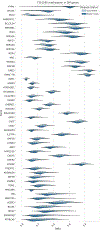Hypomethylation of miR-17-92 cluster in lupus T cells and no significant role for genetic factors in the lupus-associated DNA methylation signature
- PMID: 35710306
- PMCID: PMC10259175
- DOI: 10.1136/annrheumdis-2022-222656
Hypomethylation of miR-17-92 cluster in lupus T cells and no significant role for genetic factors in the lupus-associated DNA methylation signature
Abstract
Objectives: Lupus T cells demonstrate aberrant DNA methylation patterns dominated by hypomethylation of interferon-regulated genes. The objective of this study was to identify additional lupus-associated DNA methylation changes and determine the genetic contribution to epigenetic changes characteristic of lupus.
Methods: Genome-wide DNA methylation was assessed in naïve CD4+ T cells from 74 patients with lupus and 74 age-matched, sex-matched and race-matched healthy controls. We applied a trend deviation analysis approach, comparing methylation data in our cohort with over 16 500 samples. Methylation quantitative trait loci (meQTL) analysis was performed by integrating methylation profiles with genome-wide genotyping data.
Results: In addition to the previously reported epigenetic signature in interferon-regulated genes, we observed hypomethylation in the promoter region of the miR-17-92 cluster in patients with lupus. Members of this microRNA cluster play an important role in regulating T cell proliferation and differentiation. Expression of two microRNAs in this cluster, miR-19b1 and miR-18a, showed a significant positive correlation with lupus disease activity. Among miR-18a target genes, TNFAIP3, which encodes a negative regulator of nuclear factor kappa B, was downregulated in lupus CD4+ T cells. MeQTL identified in lupus patients showed overlap with genetic risk loci for lupus, including CFB and IRF7. The lupus risk allele in IRF7 (rs1131665) was associated with significant IRF7 hypomethylation. However, <1% of differentially methylated CpG sites in patients with lupus were associated with an meQTL, suggesting minimal genetic contribution to lupus-associated epigenotypes.
Conclusion: The lupus defining epigenetic signature, characterised by robust hypomethylation of interferon-regulated genes, does not appear to be determined by genetic factors. Hypomethylation of the miR-17-92 cluster that plays an important role in T cell activation is a novel epigenetic locus for lupus.
Keywords: autoimmunity; lupus erythematosus, systemic; polymorphism, genetic.
© Author(s) (or their employer(s)) 2022. No commercial re-use. See rights and permissions. Published by BMJ.
Conflict of interest statement
Competing interests: None declared.
Figures





Similar articles
-
Genome-wide DNA methylation study suggests epigenetic accessibility and transcriptional poising of interferon-regulated genes in naïve CD4+ T cells from lupus patients.J Autoimmun. 2013 Jun;43:78-84. doi: 10.1016/j.jaut.2013.04.003. Epub 2013 Apr 24. J Autoimmun. 2013. PMID: 23623029 Free PMC article.
-
Genome-wide DNA methylation analysis of systemic lupus erythematosus reveals persistent hypomethylation of interferon genes and compositional changes to CD4+ T-cell populations.PLoS Genet. 2013;9(8):e1003678. doi: 10.1371/journal.pgen.1003678. Epub 2013 Aug 8. PLoS Genet. 2013. PMID: 23950730 Free PMC article.
-
MicroRNA-21 and microRNA-148a contribute to DNA hypomethylation in lupus CD4+ T cells by directly and indirectly targeting DNA methyltransferase 1.J Immunol. 2010 Jun 15;184(12):6773-81. doi: 10.4049/jimmunol.0904060. Epub 2010 May 17. J Immunol. 2010. PMID: 20483747
-
Impaired DNA methylation and its mechanisms in CD4(+)T cells of systemic lupus erythematosus.J Autoimmun. 2013 Mar;41:92-9. doi: 10.1016/j.jaut.2013.01.005. Epub 2013 Jan 20. J Autoimmun. 2013. PMID: 23340289 Review.
-
Epigenetic Contribution and Genomic Imprinting Dlk1-Dio3 miRNAs in Systemic Lupus Erythematosus.Genes (Basel). 2021 May 1;12(5):680. doi: 10.3390/genes12050680. Genes (Basel). 2021. PMID: 34062726 Free PMC article. Review.
Cited by
-
Epigenome-wide association study of serum folate in maternal peripheral blood leukocytes.Epigenomics. 2023 Jan;15(1):39-52. doi: 10.2217/epi-2022-0427. Epub 2023 Mar 28. Epigenomics. 2023. PMID: 36974632 Free PMC article.
-
Childhood-onset systemic lupus erythematosus: characteristics and the prospect of glucocorticoid pulse therapy.Front Immunol. 2023 Aug 10;14:1128754. doi: 10.3389/fimmu.2023.1128754. eCollection 2023. Front Immunol. 2023. PMID: 37638017 Free PMC article. Review.
-
The multiple roles of interferon regulatory factor family in health and disease.Signal Transduct Target Ther. 2024 Oct 9;9(1):282. doi: 10.1038/s41392-024-01980-4. Signal Transduct Target Ther. 2024. PMID: 39384770 Free PMC article. Review.
-
Methyl-donor supplementation in women with systemic lupus erythematosus with different nutritional status: the protocol for a randomised, double-blind, placebo-controlled trial.Lupus Sci Med. 2024 Oct 7;11(2):e001279. doi: 10.1136/lupus-2024-001279. Lupus Sci Med. 2024. PMID: 39375179 Free PMC article.
-
Methylation of T and B Lymphocytes in Autoimmune Rheumatic Diseases.Clin Rev Allergy Immunol. 2024 Jun;66(3):401-422. doi: 10.1007/s12016-024-09003-4. Epub 2024 Aug 29. Clin Rev Allergy Immunol. 2024. PMID: 39207646 Review.
References
-
- Lewis MJ, Jawad AS. The effect of ethnicity and genetic ancestry on the epidemiology, clinical features and outcome of systemic lupus erythematosus. Rheumatology (Oxford). 2017. Apr 1; 56(suppl_1):i67–i77. - PubMed
Publication types
MeSH terms
Substances
Grants and funding
LinkOut - more resources
Full Text Sources
Medical
Research Materials
Miscellaneous

